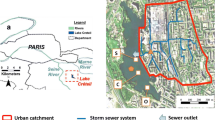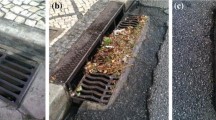Abstract
Urban stormwater runoff discharged through sewer systems into streams causes flush spills of water and pollutants in the receiving water. To make the right decisions in future plannings of the very costly rehabilitation of sewer systems, a solid ecological data base on the critical parameters of sewer overflows is badly needed. Therefore, we designed a laboratory flume which was operated in circular flow mode (to ensure adaptation of the test organisms) and in flow-through mode during the simulation of sewer overflows (to allow a proper evaluation of population loss by drift). Examples on the behaviour during the adaptation phase and the population loss during the exposure to flush spills of water and/or a mixture of sewage and clean water of a benthic invertebrate (Gammarus pulex) demonstrate the potential of the flume to identify critical parameters of sewer overflows at “quasireal-world-conditions”. We found clear evidence for synergetic effects since the exposure to high flow and sewage caused higher population loss ofGammarus than the sum of population loss at exposure to only high flow or only sewage. Population loss considerably depended on the availability of refugial space: if the interstices of the gravel in the flume were silted, this loss was higher than at open interstices. Only ten minutes of movement of the material forming the flume bottom reduced the population ofGammarus to about 60 or 50% of its initial size. Hence, our data strongly suggest that the characteristics of the receiving stream (refugial space, bed stability) play an important role for the potential ecological impact of a sewer overflow. Changes of stream morphology and/or creation of refugial space plus an appropriate technical solution for overflow treatment may be less costly and more effective than a large-scale technical project. Thus, the stream itself should be a major element in future management decisions.
Similar content being viewed by others
References
Ambühl, H., 1959. Die Bedeutung der Stömung als ökologischer Faktor. Schweiz. Z. Hydrol. 21:133–264.
Blohm, H.-P. and D. Borchardt, 1989. Stoßartige Belastungen in Fließgewässern — Auswirkungen auf ausgewählte Organismengruppen und deren Lebensräume. Schriftenreihe Deutsch. Verband Wasserwirtschaft Kulturbau 88:211–271.
DIN, 1983. Bestimmung der Korngrößenverteilung durch Siebung und Sedimentation (DIN 1810023). Deutsches Institut für Normung (Normenausschuß Bauwesen), Beuck Verlag, Berlin.
DIN, 1985. German standard methods of the examination of water, waste water and sludge: Determination of Ammonia-Nitrogen (DIN 38405-E5). Deutsches Institut für Normung (Gesellschaft Deutscher Chemiker und Normenausschuß Wasserwesen), VCH Verlagsgesellschaft, Weinheim.
Emerson, K., R. C. Russo, R. E. Lund and R. V. Thurston, 1975. Aqueous ammonia equilibrium calculations: effects of pH and temperature. J. Fish. Res. Board Can. 32:2379–2383.
Gammeter, S. and A. Frutiger, 1989. Wirkung kurzer Belastungsspitzen auf die Kleinlebewesen der Flußsohle. Gaz Eaux Eaux usées 69:703–713.
Garric, J., B. Migeon and E. Vindimian, 1990. Lethal effects of draining on brown trout. A predictive model based on field and laboratory studies. Water Res. 24:59–65.
Hogendoorn-Roozemond, A. S., 1985. Combined sewer overflow pollution abatement. In: J. C. Hooghart (ed.), TNO Committee Hydrol. Res. 33, TNO, The Hague: Water in urban areas, pp. 115–127.
Krauth, K. and G. Stotz, 1985. Minimierung des Schmutzstoffeintrages aus Siedlungsgebieten in Vorfluter. Deutsche Forschungsgemeinschaft, Schlußbericht Kr 624/3-2, Stuttgart.
Lamberti, G. A., L. R. Ashkenas, S. V. Gregory and A. D. Steinman, 1987. Effects of three herbivores on periphyton communities in laboratory streams. J. N. Am. Benthol. Soc. 6:92–104.
Meijering, M. P. D., 1972. Experimentelle Untersuchungen zur Drift und Aufwanderung von Gammariden in Fließgewässern. Arch. Hydrobiol. 70:133–205.
Metcalfe, J. L., 1989. Biological water quality assessment of running waters based on macroinvertebrate communities: history and present status in Europe. Environ. Pollut. 60:101–139.
Pecher, R., 1988. Sind Regenüberläufe so schlecht wie ihr Ruf? Korrespondenz Abwasser 35:660–667.
Statzner, B. and A. Bittner, 1983. Nature und causes of migrations of Gammarus fossarum Koch (Amphipoda) — a field study using a light intensifier for the detection of nocturnal activities. Crustaceana 44:271–291.
Statzner, B., C. Dejoux and J.-M. Elouard, 1984. Field experiments on the relationship between drift and benthic densities of aquatic insects in tropical streams (Ivory Coast). 1. Introduction: review of drift literature, methods, and experimental conditions. Rev. Hydrobiol. trop. 17:319–334.
Statzner, B., J.-M. Elouard and C. Dejoux, 1987. Field experiments on the relationship between drift and benthic densities of aquatic insects in tropical streams (Ivory Coast). 3. Trichoptera. Freshwater Biol. 17:391–404.
Statzner, B., J. A. Gore and V. H. Resh, 1988. Hydraulic stream ecology: observed patterns and potential applications. J. N. Am. Benthol. Soc. 7:307–360.
Statzner, B. and R. Müller, 1989. Standard hemispheres as indicators of flow characteristics in lotic benthos research. Freshwater Biol. 21:445–459.
Ten Hove, D., M. A. De Ruiter and D. Vat, 1985. The effect of storage settling tanks on pollution emission from combined sewer systems. In J. C. Hooghart (ed.), TNO Committee Hydrol. Res. 33, TNO, The Hague: Water in urban areas, pp. 129–142.
Thyssen, N., M. Erlandsen, E. Jeppesen and C. Ursin, 1987. Reaeration of oxygen in shallow, makrophyte rich streams: I. — Determination of the reaeration rate coefficient. Internat. Revue ges. Hydrobiol. 72:405–429.
Uunk, E. J. B., 1985. Urban stormwater runoff pollution. In: J. C. Hooghart (ed.), TNO Committee Hydrol. Res. 33, TNO, The Hague: Water in urban areas, pp. 77–98.
Vat, D., 1985. Pollution emission from combined sewer systems; a full scale investigation programme. In: J. C. Hooghart (ed.), TNO Committee Hydrol. Res. 33, TNO, The Hague: Water in urban areas, pp. 99–113.
Widera, J., J. Rennerich, B. Thiesmeier and S. Darschnik, 1989. Wiederbesiedlung eines rückgebauten Stadtbaches unter dem Einfluß von Regenauslässen. Verh. Ges. Ökol. Essen 1988:569–572.
Willemsen, G. D., H. F. Gast, R. O. G. Franken and J. G. M. Cuppen, 1989. Urban stormwater discharges: effects upon communities of sessile diatoms and macro-invertebrates. Proc 2nd Wageningen Conf. “Urban storm water quality and ecological effects upon receiving waters”:8 pp.
Author information
Authors and Affiliations
Rights and permissions
About this article
Cite this article
Borchardt, D., Statzner, B. Ecological impact of urban stormwater runoff studied in experimental flumes: Population loss by drift and availability of refugial space. Aquatic Science 52, 299–314 (1990). https://doi.org/10.1007/BF00879759
Received:
Issue Date:
DOI: https://doi.org/10.1007/BF00879759




